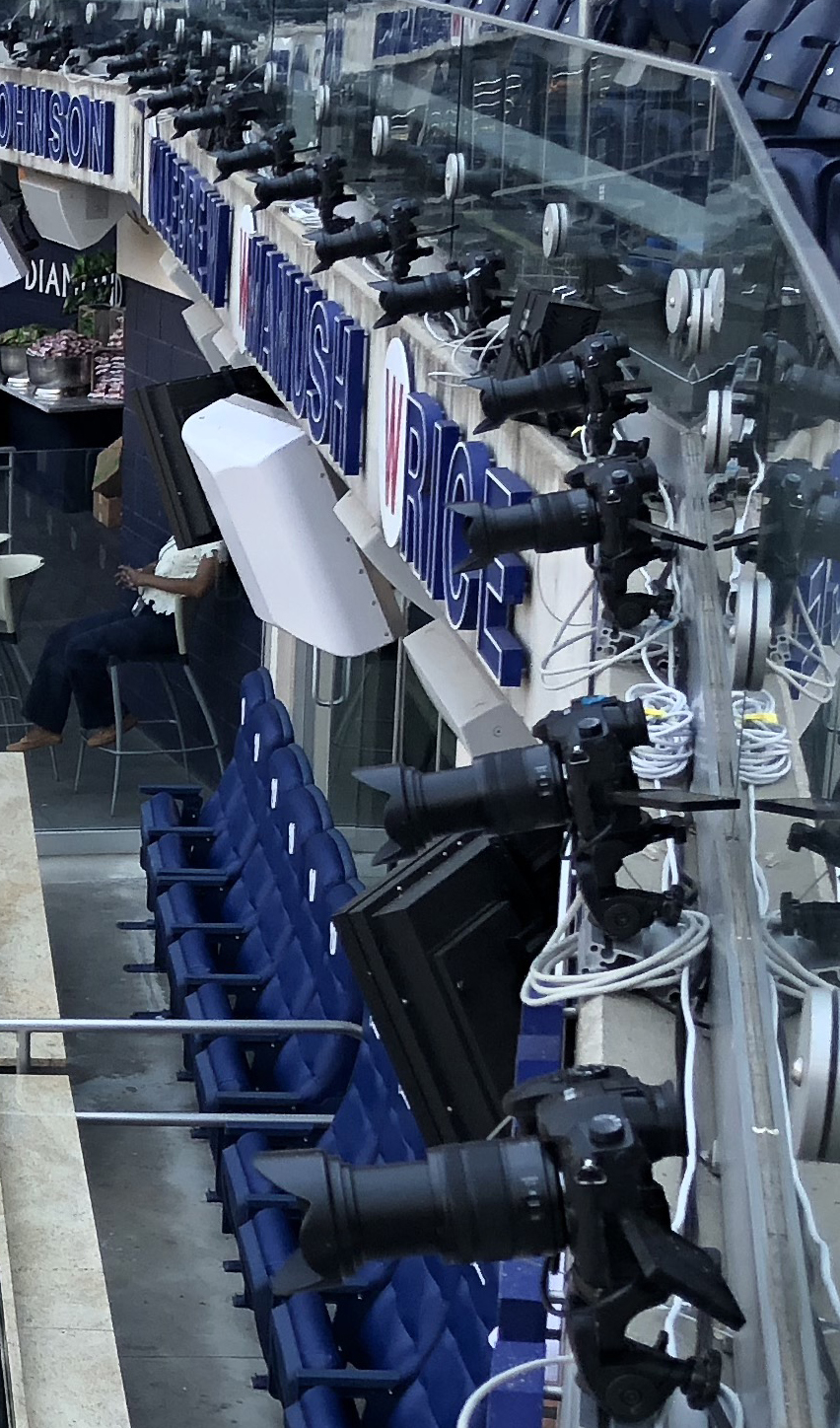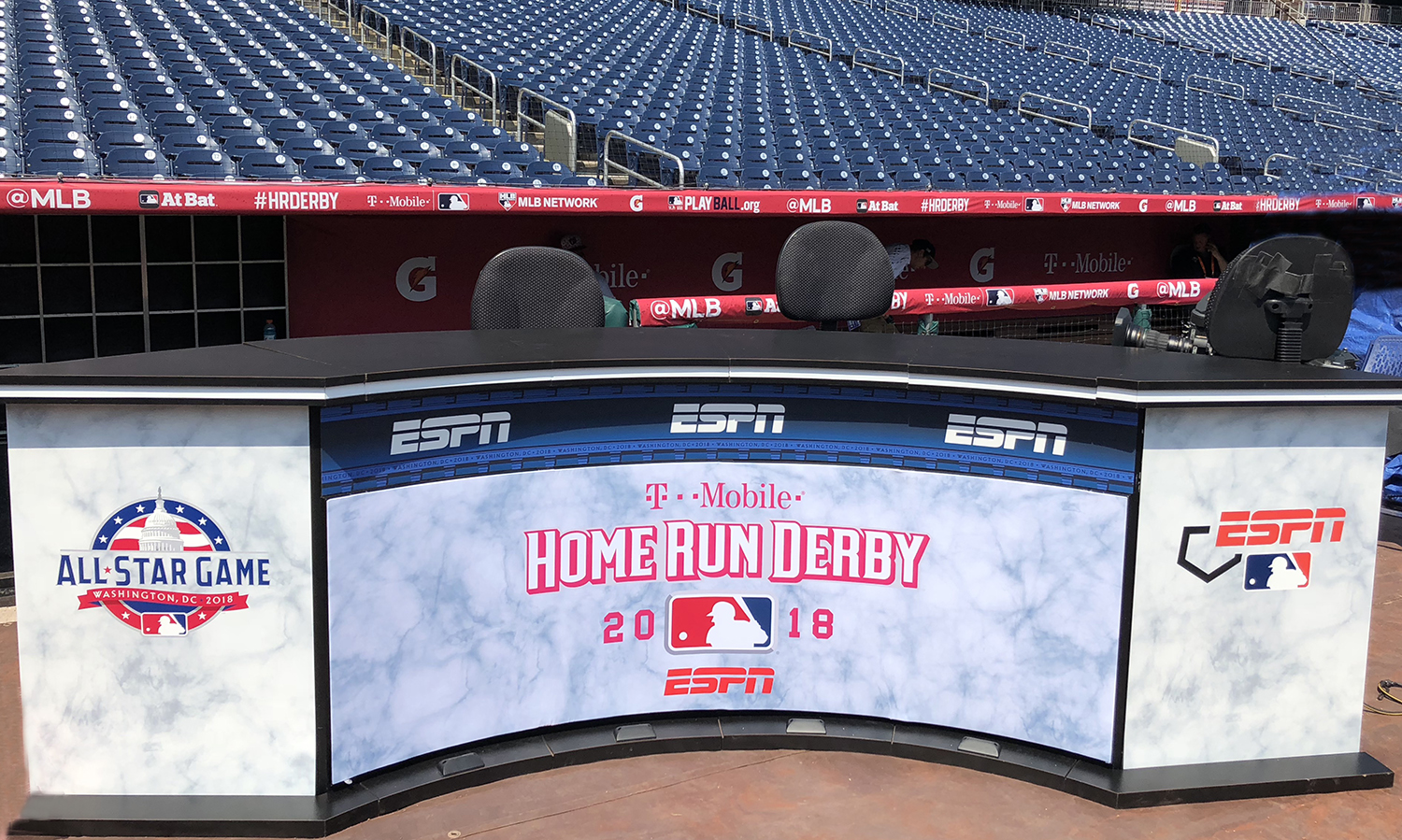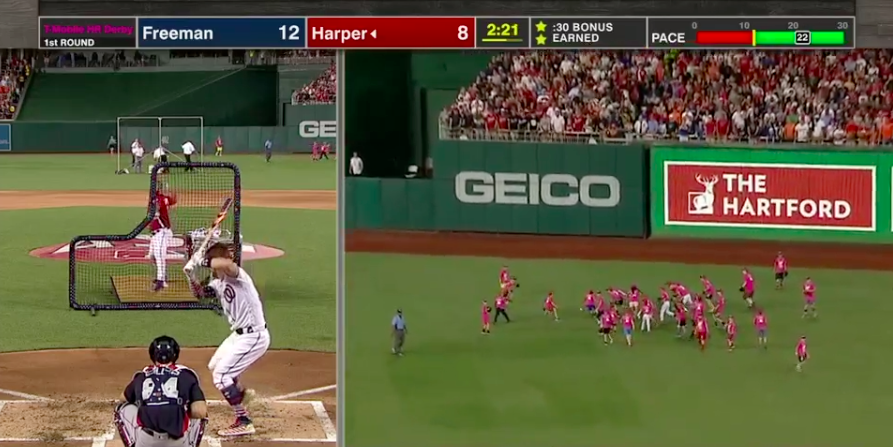Live From MLB All-Star: ESPN Adds New Dimensions to Home Run Derby With 4D Replay, 3D Spray Charts
The goal is to offer viewers more detail, more data
ESPN is thinking outside the 2D box for this year’s Home Run Derby, deploying a 4D Replay system that will provide 360-degree replays of homers and debuting 3D spray charts that will show paths and arcs of home runs on a virtual field.
“We’re trying some new things out this year that we’re really excited about,” says Phil Orlins, senior coordinating producer for MLB, ESPN. “We’ve used the 4D Replay system a few times now, and we were pleased with it and had a lot of success with it. So it should be a great addition. And then we’ve been starting to play a little more aggressively with interpreting data into a virtual environment with 3D K-Zone and, at the Derby, we’re advancing those [efforts] with the full [3D spray chart] to track home runs.”
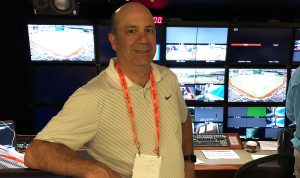
ESPN’s Phil Orlins: “We’re going to focus on high-end analysis and statistics. We want it to have a different flavor and appeal to a different type of viewer.”
Of course, ESPN’s presence at Washington’s Nationals Park goes well beyond just the Derby. The network will have a total of six productions onsite: the Derby, Baseball Tonight, SportsCenter, Pardon the Interruption, ESPN Deportes, and, most notably, a new MLB Statcast-fueled alternative viewing experience on ESPNEWS.
“The key phrase this year is strategic sharing,” says Paul Horrell, remote operations manager for MLB, ESPN. “The logistical challenges of sharing not only production space but also all the equipment, the set locations, managing the comms and transmission are just a daunting task. But, thankfully, we’ve got it all buttoned up very well. It’s true we’ve had a lot of practice at this point, but this is going be a very big show regardless.”
Dingers From Every Angle: 4D Replay Make HR Derby Debut
The 4D Replay system relies on 60 4K cameras mounted on the concourse level behind home plate and stretching from first to third base.
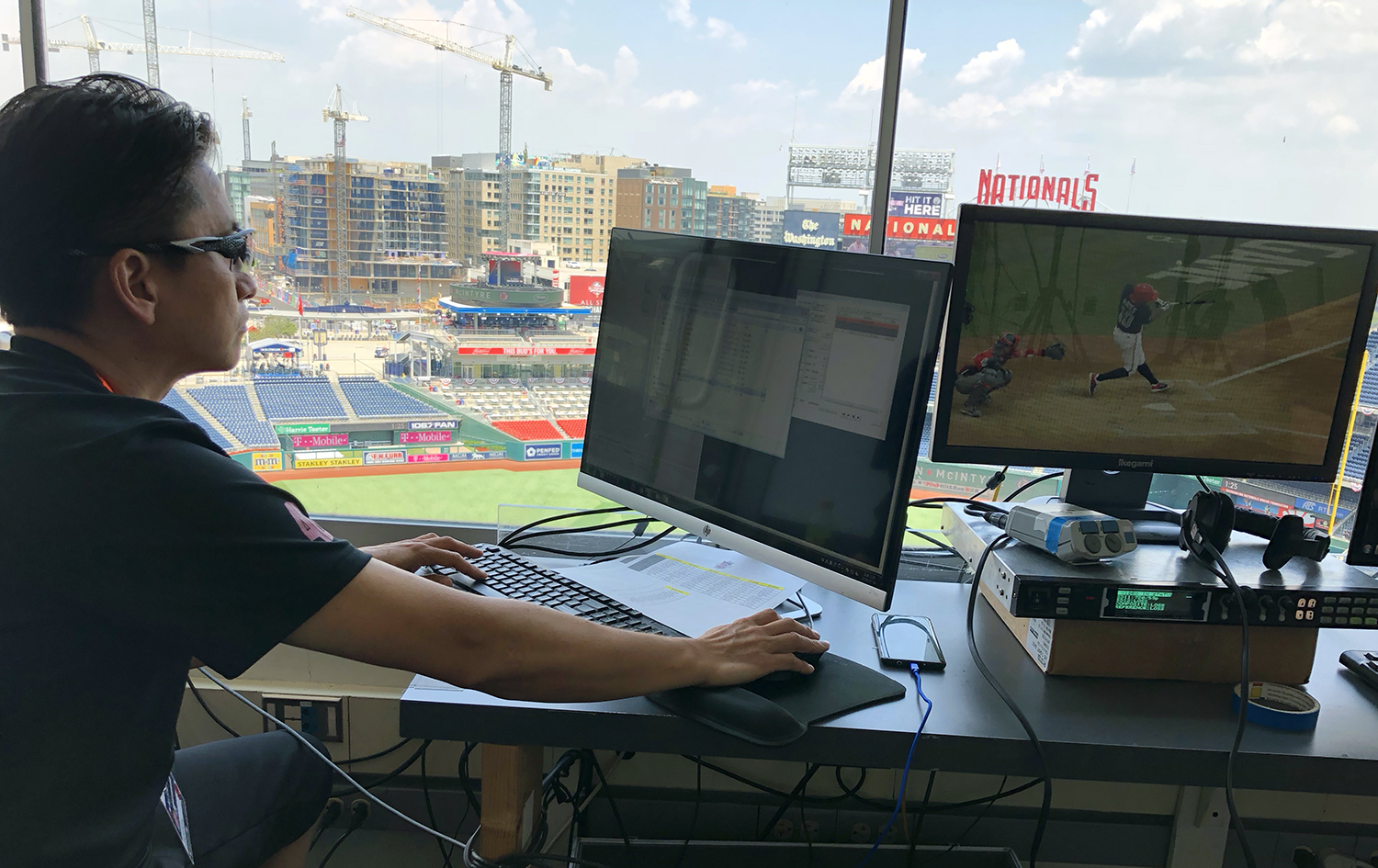
Using feeds from 60 4K cameras, the 4D Replay operator can manipulate the replay from side to side, as well as zoom in without losing resolution (thanks to 4K cameras).
The cameras are tied together, and, for each play, the single operator selects the pivot point on which the camera axis turns. The operator can then manipulate the replay from side to side and can zoom in without losing resolution (thanks to 4K cameras).
Since the system simply stitches together 60 camera feeds and does not have to virtually create filler frames, no rendering is required, allowing 4D Replay clips to be ready in under 10 seconds. The replay is sent via fiber to ESPN’s truck, where an EVS channel constantly records the feed and the production team has the option to take it when it likes.
ESPN deployed the 4D replay system first on June 4 at AT&T Ballpark in San Francisco (where the system is permanently installed this season) and then again for three games at Dodger Stadium (June 24-26). These system require significantly more cameras since they also create 4D Replays from the pitchers mound and all three bases in addition to home plate.
“By the second and third game, we were already using it a lot,” says Orlins. “The turnaround time was extremely fast at under 10 seconds, so we usually hit in our first or second replay, which was a huge step. And, obviously, the 4K aspect of it allows us to get a tremendous amount of detail and get in very close. At the Derby, the hope and expectation is that we use it as much as possible.”
Getting Graphic: 3D Spray Charts and Pace Tracker
After debuting at last year’s AL Wild Card Game, the 3D K-Zone has become a staple of ESPN’s MLB coverage this year. The system is now fully automated, ingesting Statcast data, automatically rendering a replay for every pitch, and feeding it to a dedicated EVS channel (it is used about five times per game on average this season). The network is taking its work in 3D virtual space to the next level at the Home Run Derby tonight with the debut of 3D spray charts that will show paths and arcs of home runs.
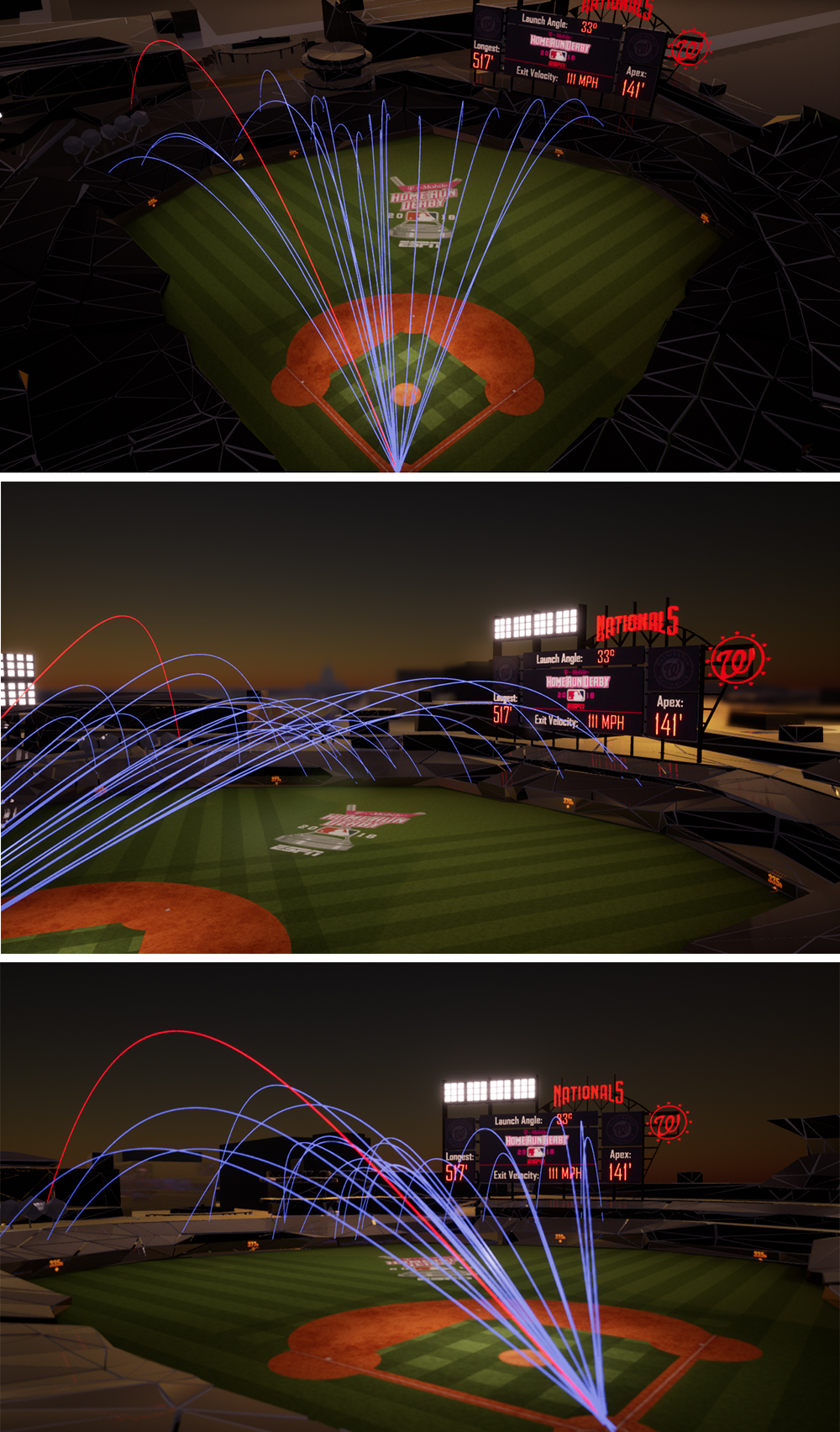
At Home Run Derby, ESPN will debut 3D spray charts that use Statcast data to show home-run paths and arcs.
“The 3D K-Zone has been very well-received, and it has been a great tool for production. We’re looking to build on that here at the Derby with the [3D spray charts],” says Christian Cokas, associate director, creative innovation, ESPN. “There is a lot of data through Statcast that we want to take advantage of. This is one of our next steps to do that.”
Cokas and the creative-innovation team — including Manager of Software Engineering Jeffrey Bradshaw and Senior Creative Developer Brian Rooney — have been working on several virtual-3D applications leveraging Statcast data, including a pitch-comparison tool, throughout this season. When producer Scott Matthews approached the team a month ago about adding new elements for the Home Run Derby, Bradshaw showed him the 3D spray chart, and the project was off and running.
“Jeff had been working on this for a while. He showed Scott the spray chart, and he loved it,” says Cokas. “That was about a month ago; it has been very quick development from there. The goal is to make it more of an automated tool that does not have to be manually operated.”
The team created a virtual version of Nationals Park, reflecting the dimensions and basic look of the ballpark. Currently, the system is similar to the original 3D K-Zone system before it was automated so that Bradshaw and Rooney still have some control. They manually select hits that are home runs, clear out those that weren’t, and pick a virtual camera view to trigger an animation. Based on where the home runs land, they pick a camera move that looks good, animate that, and feed it out to the tape producer.
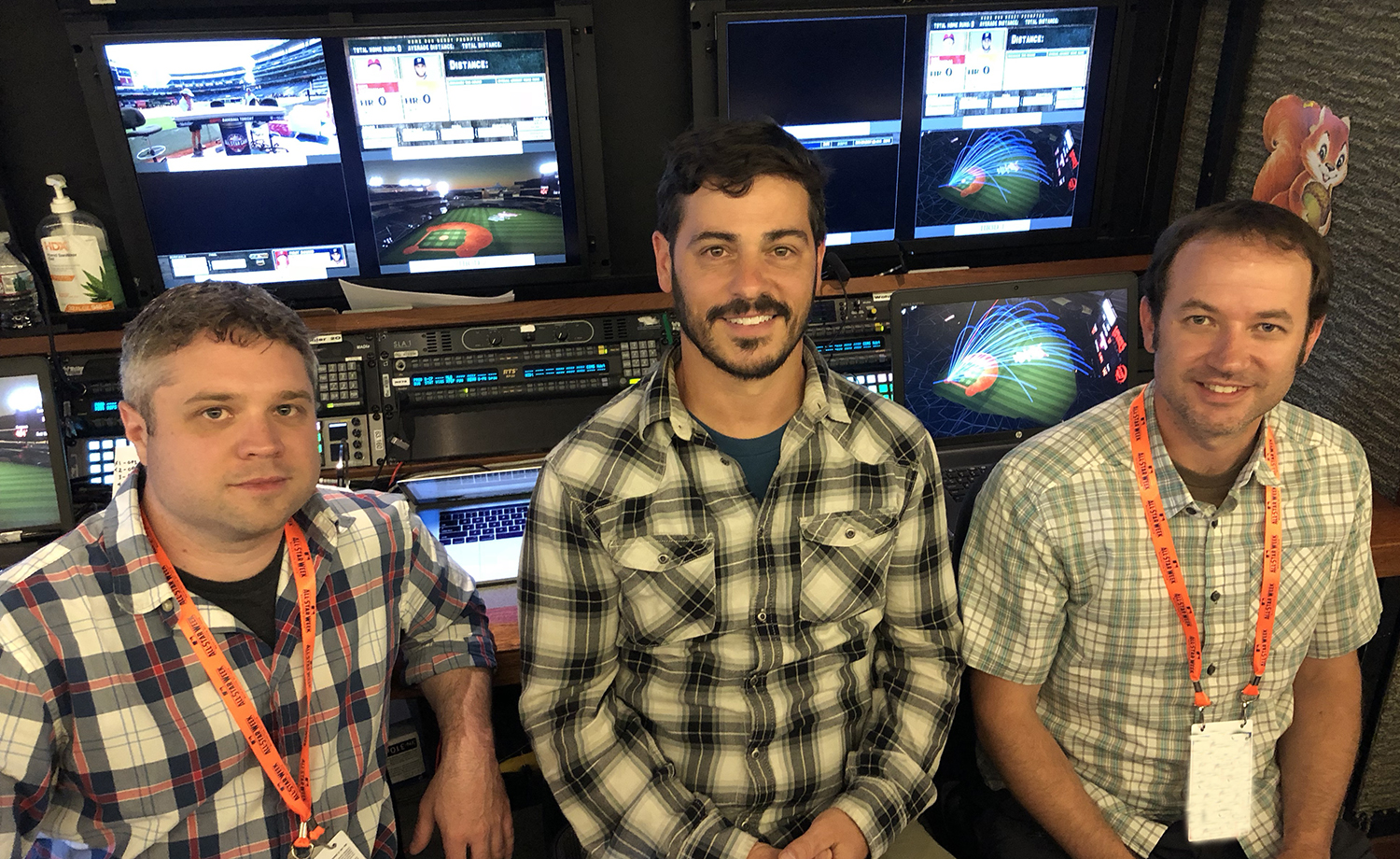
ESPN Creative Innovation’s (from left) Brian Rooney, Christiaan Cokas, and Jeffrey Bradshaw will be handling 3D-spray-chart production for Home Run Derby.
A red line shows the longest home run of the round, and the data on the virtual scoreboard that home run’s distance, exit velocity, and apex. Bradshaw will be operating the system for the main HR Derby show, while Rooney operates a separate system for the ESPNEWS alternative-experience show.
Also new this year on the graphics front will be an on-screen scoreboard featuring a “pace tracker,” which features a sliding scale of projected home-run totals for each hitter in the bracket and notes whether the hitter’s total is ahead or behind his opponent.
“I give full credit for that to our producer, Scott Matthews,” says Orlins. “It’s not unprecedented technology, but I think it’s a great tool: fans don’t have to be calculating in their head how a guy is doing compared with the leader.”
Deep Analytics: Statcast Takes Center Stage on ESPNEWS
ESPNEWS is debuting a first-of-its-kind alternative viewing experience for the Derby tonight.
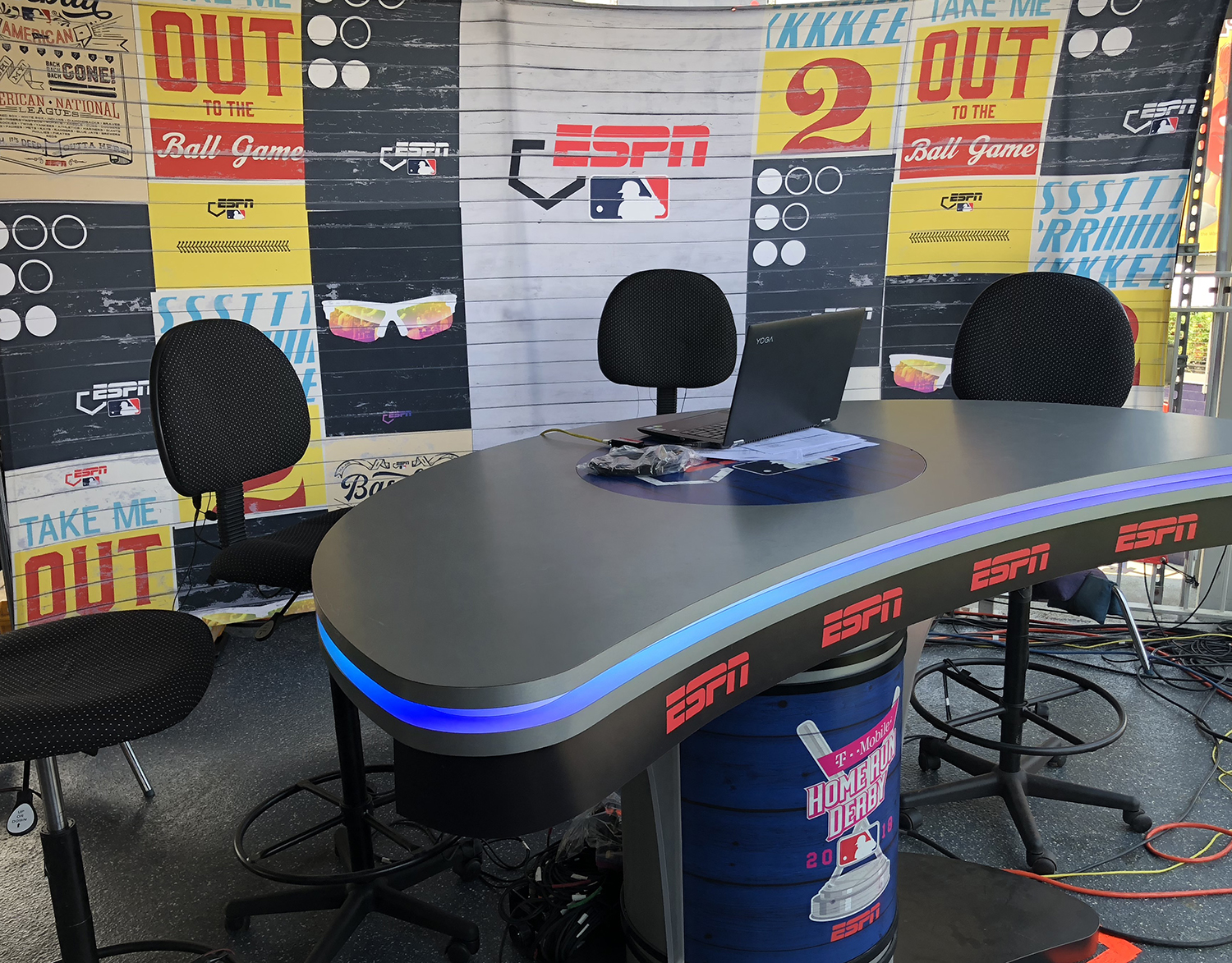
ESPN will deliver a Statcast-fueled alternative viewing experience for the HR Derby on ESPNEWS from this set.
Driven largely by on-screen graphics, data, and information from MLB’s Statcast system, this telecast will have its own commentator team — play-by-play voice Jason Benetti, analyst Eduardo Perez, and, periodically, MLB.com Statcast expert Mike Petriello — and feature two constant lower-third graphics: a “launch pad” graphic in the lower left corner of the screen displaying launch angle, distance, and exit velocity for every home run and a graphic in the lower right displaying various Derby stats, such as longest and hardest-hit home runs of the night.
“The primary visual coverage is going to be pretty similar to the main derby in terms of the video, but we’ll be doing a lot more with graphics,” says Orlins. “We’re going to focus on high-end analysis and statistics. We want it to have a different flavor and appeal to a different type of viewer, but, at the same time, we don’t want that type of viewer to feel like they’re sacrificing anything by watching this. So they’ll be seeing most of the same shots of the hitters that they would see in the main [ESPN telecast].”
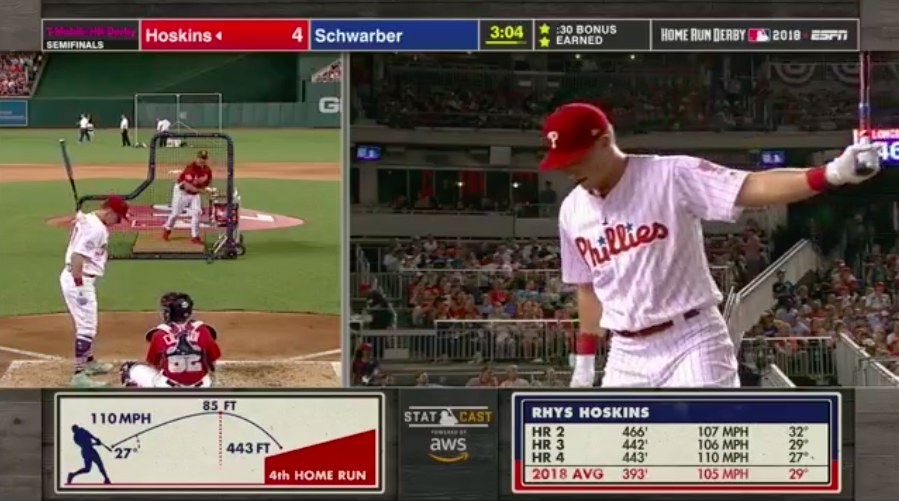
The Statcast-fueled alternative experience on ESPNEWS features feature two constant lower-third graphics.
ESPN will also provide Perez with a 4D Replay touchscreen app on a tablet, allowing him to create 4D replays that will be integrated into the telecast.
“I’ve always believed in giving more control to analysts, rather than trying to guess exactly what they’re looking for as a producer. Because there are so many decisions to make, I think actually putting [the 4D Replay system] in the hands of the person who is talking about it on-air is the easiest way to get the best result.”
A Sextet of Productions: In the Compound, on the Set, and on the Field
All six ESPN productions at MLB All-Star are being run out of NEP’s EN1 mobile units (A, B, C, and D) with three separate production spaces serving the various entities. The main Home Derby production is housed in the main A unit control room, while a second control room has been created inside the A unit for the onsite studio shows and alternative viewing experience on ESPNEWS shows. In addition, a third control room has been created in the D unit for ESPN Deportes (which is also being used by Pardon the Interruption).
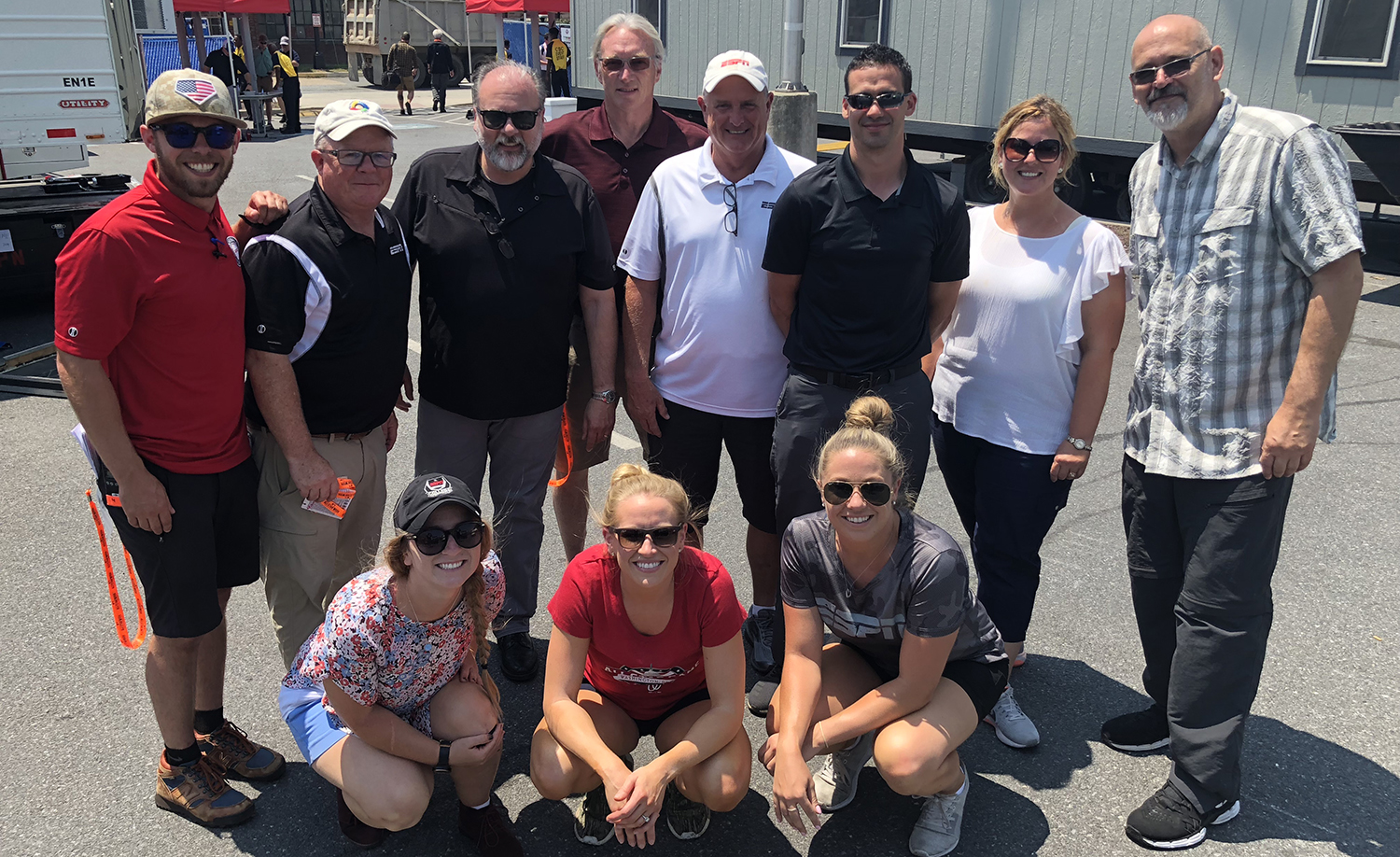
The ESPN ops team at its MLB All-Star compound in Washington: Back row (from left): Kyle Dean, Fred Clow, Paul Horrell, Kevin Cleary, Terry Cook, DJ Driscoll, Cindy Pennington, Rex Arends; Front row: Leigh Michaud, Jill Clark, Kelsey Hahn. Also on hand were Jim Orton and Michelle Mancini.
“We have a lot of horsepower in that truck,” says Horrell. “You can configure it in so many different ways, which is a huge benefit for us.”
In all, ESPN will deploy more than 30 cameras for its various productions at National Park, including seven robos from Fletcher (two of which are 6X-slo-mo Grass Valley LDX 86’s and one I-MOVIX Phantom 4K), four RF cameras from CP Communications (three handhelds and one Steadicam), and a TVU Networks IP/bonded-cellular system.
Eight effects mics will also be buried in the infield to capture audio during the Home Run Derby and Celebrity Softball Game.
To serve its cavalcade of studio programming and other entities onsite, ESPN will have three on-field sets, two booth locations, and stage on the left-field concourse area for the ESPNEWS alternative viewing experience.
In terms of transmission, ESPN has established 11 dedicated fiber paths between the venue and its headquarters in Bristol, CT: seven outbound paths and four returns. For redundancy, ESPN is relying on an IP path rather than a satellite uplink.
“Those will be strategically managed,” says Horrell, “because, obviously, there are only so many lines available, and there’s a lot of different production entities onsite.”
The alternative viewing experience on ESPNEWS will deploy a GREMI (graphics remote integration) model with graphics and EVS replay operators located in Bristol. Horrell says the GREMI model has become standard across all three of ESPN’s weekly MLB productions with Vizrt graphics, 3D K-Zone, and three EVS replay operators in Bristol.
“I can’t say enough about the people on our [ops] teams,” says Horrell. “It takes a ton of time and dedication because this show is a tremendous logistical challenge with all the sharing of resources and so many entities onsite. They’re just knocking it out of the park, and they do a fantastic job. Of course, we have eight other operations people here as well to handle everything from the event itself to all the different studio shows. It’s a well-oiled machine.”
Embracing the Two-Box: Split Screen for Derby and 30-Second ‘Floater’ Commercials
ESPN has embraced the “two-box” format throughout its MLB coverage this season, often showing two video feeds in the same frame to provide live look-ins of other games or multiple events taking place within the game it’s covering. That trend will continue at the Derby Monday night when ESPN deploys a split screen for the second consecutive year to keep up with the ultra-rapid pace of players hitting as many homers as they can in four minutes.
“There’s just no question you need [a two-box frame] with the way the Derby is formatted now and the speed of it,” says Orlins. “This opens it up and allows you to be much more comfortable as a viewer because you know what’s going on with the pitcher and the batter and the next pitch but you also get to see the ball go into the crowd and the reaction shots of the players and the fans.”
In addition, ESPN will once again deploy the two-box commercial approach it debuted at last year’s Derby. The network will increase the number of 30-second commercials integrated into the telecast between hitters or during a timeout from eight last year to 15 this year.
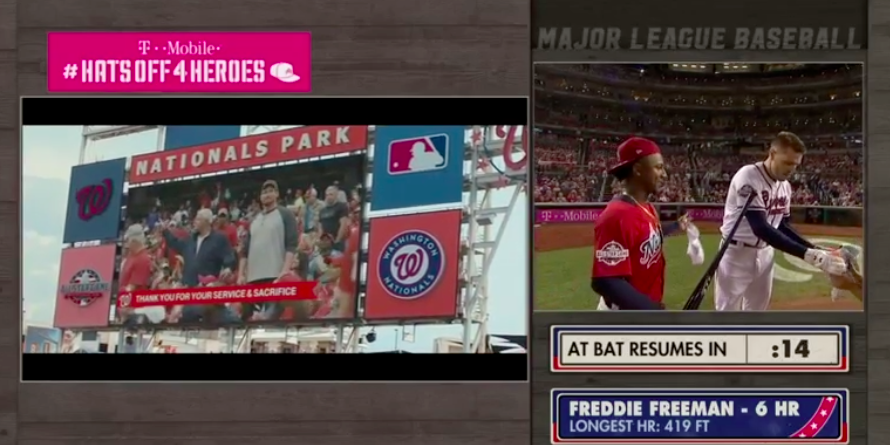
ESPN is including 15 “floater” 30-second commercial spots during its Derby coverage, up from eight last year.
“It has allowed us to create a format where we’re taking only one commercial break during the entire first round and one during the entire quarterfinals,” says Orlins. “That means we will only have to take one break in what should be about the first hour of the Derby, so we’re pretty excited about that.”
For more of SVG’s on-site coverage from Washington D.C., visit the SportsTechLive Blog: On Site at MLB All-Star 2018.

